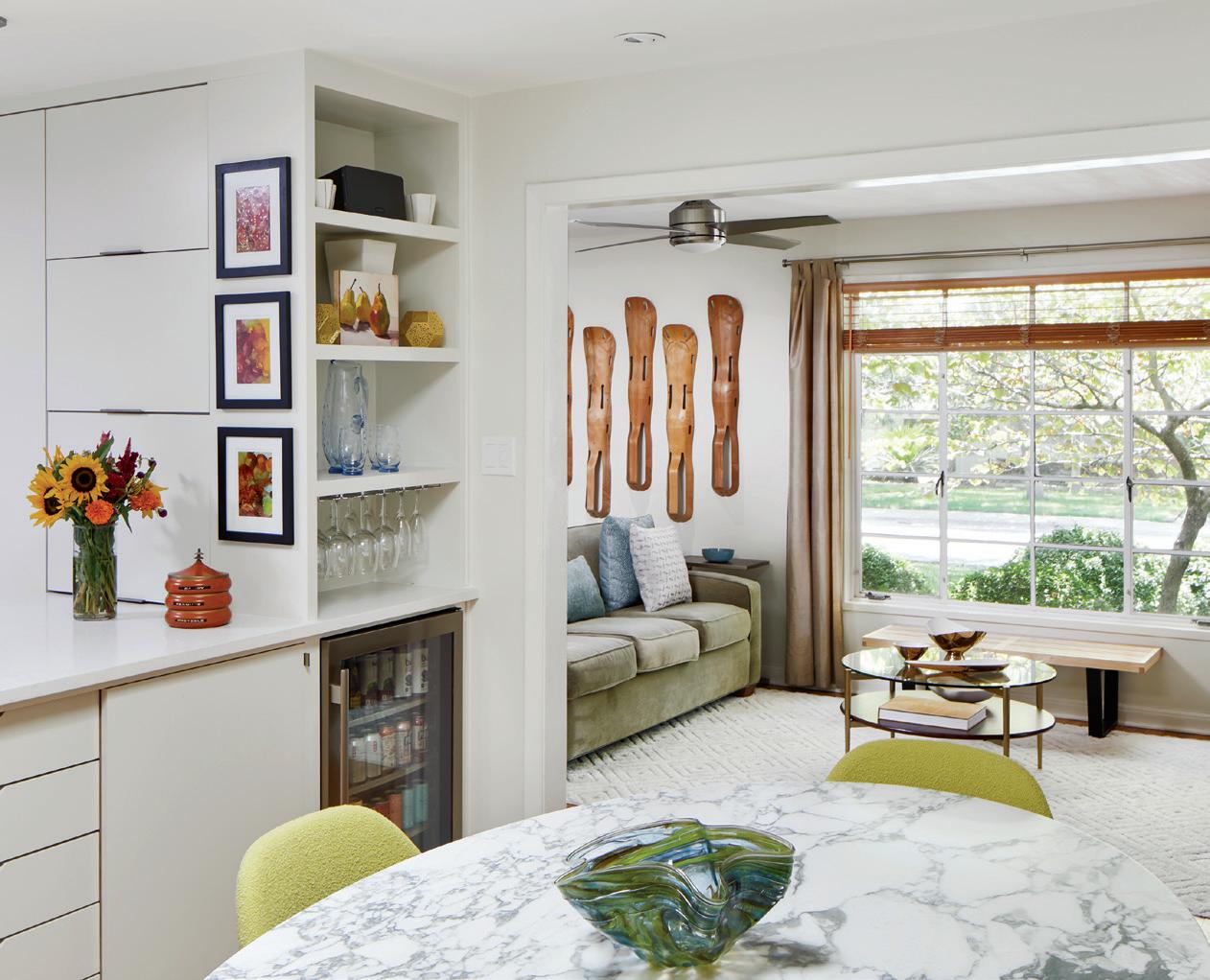
4 minute read
Personal Project
By Claudia Alarcón Photography by Andrea Calo
Architect Jennifer Vrazel from Studio Steinbomer
Advertisement
has worked on countless kitchen designs and
remodels in her career, always listening to her
clients’ needs and wants. So, how did things go
when it was time to redesign her own kitchen?
T

he house was built in 1952 in a simple ranch-style design common to that era. The kitchen is in the center of the house, open to the dining, living and family rooms, and is the core area for entertaining. Although functional, the style of the cabinets and the finishes were somewhat dated. “Because it is so open to the rest of the house — it’s truly the heart of the house — we wanted it to reflect the mid-century modern aesthetic that is prevalent throughout the rest of the house,” says Vrazel.
Design and planning for the kitchen began months before

the renovation. The team selected Paul Mulligan as the contractor, and he took an active role in the planning process. Several meetings with subcontractors took place on site in order to understand the existing conditions and the proposed changes to minimize surprises once construction started. Fixtures and finishes were purchased in advance and stored on site, and cabinets and appliances were selected a couple of months before construction commenced. Once the cabinets were built, demolition began and construction immediately followed.
As with any outdated kitchen, storage was a problem. Without the ability to increase the size of the kitchen, Vrazel
needed to maximize the current space through clever design of cabinetry and storage areas. “The inability to expand the footprint was one of the biggest challenges,” she says. “The kitchen and dining area share the same space, so while we needed more storage, we couldn’t afford to lose any room for dining. The new kitchen needed to occupy the same footprint as the old kitchen, and we somehow needed to accommodate more — and useful — storage.”
The previous kitchen cabinetry consisted primarily of deep cabinets which, as opposed to drawers, probably accommodate the most amount of storage. “But deep cabinets are difficult to access, and stuff tends to get shoved to the back, never to be found until it’s time to renovate,” says Vrazel. “At least, that was our case!” In the new design, drawers were a must. Even though they yield a little less storage capacity, the ease of accessibility and functionality outweighs any amount

of inaccessible storage. “So, with careful curating of kitchen accoutrements, we have plenty of storage for everything, and we can even store other items that were tucked away in other areas of the house,” she adds.
The modern, frameless, European-style cabinets were custom built by River City Cabinets. “I can’t recommend them enough,” she says. “The quality is top-notch, and the service is superb. We priced out prefab cabinets and were surprised at how competitively priced custom cabinets can be. It was the obvious choice, and I got exactly what I wanted.” They’re painted in Sherwin-Williams® Oyster White and complement the Caesarstone® Frosty Carrina counters and the adjacent Saarinen table with an Arabescato marble top.
Another challenge was getting more natural light into the kitchen, which only had one small window over the sink and an abundance of shade trees outside. “We added a sky
light in the dining area years ago which transformed the space, but the kitchen was still dark,” says Vrazel. “Due to very low ceilings throughout, and a low-slope roof with no attic space, adding a skylight was going to be a costly endeavor because we would need to reroute ductwork plumbing, electrical, etc., to accommodate it. The solution was a Velux® solar tube — now the kitchen is the brightest room in the house!”
Since the dining area is adjacent and open to the kitchen, the side of the peninsula facing the dining room was designed with entertaining in mind, boasting open shelves for glassware, an undercounter beverage refrigerator and built-ins reminiscent of mid-century modern credenzas. By creating this delineation of space, Vrazel can remain on the work side of the peninsula while guests have access to beverages, snacks and seating on the other side.
While this type of project doesn’t leave much opportunity to go completely green, they utilized under the counter LED tape light, Tech Lighting over the sink, peninsula and dining sconces and Contech 4-inch adjustable recessed lights throughout, as well as high-efficiency appliances.
Small aesthetic details added a bit of whimsy and livened the space. “The backsplash tile is one of my favorite things about the kitchen,” says Vrazel. “It was one of the few selections that both my husband and I could agree upon, and I love the oval shape — it complements our oval dining table.” The tile is enhanced by a metallic Diamond Grout by Bosticks. The soft, neutral palette of colors allows for artwork, furnishings and decorative objects to pop, much like in the rest of the home. The overall goal of the renovation was to make a kitchen that was clean and modern, but not trendy or something that would be dated in a few years. “We made selections that we felt would stand the test of time.” u
STUDIO STEINBOMER ARCHITECTURE & INTERIORS 512-479-0022 | www.steinbomer.com











